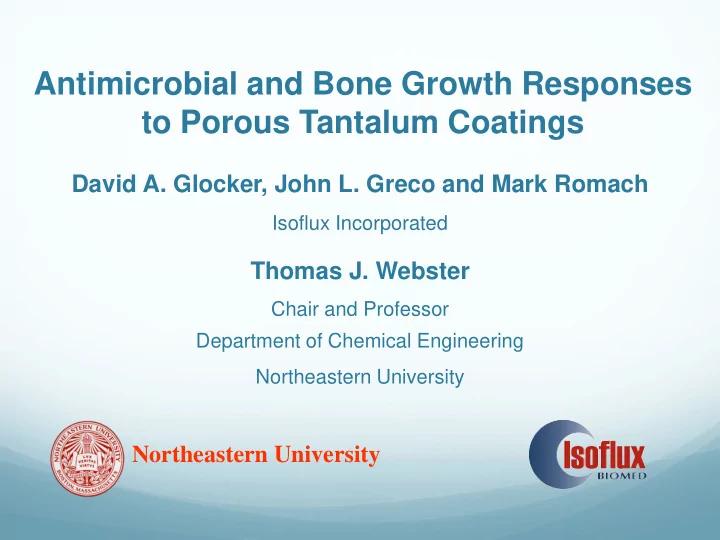

Antimicrobial and Bone Growth Responses to Porous Tantalum Coatings David A. Glocker, John L. Greco and Mark Romach Isoflux Incorporated Thomas J. Webster Chair and Professor Department of Chemical Engineering Northeastern University Northeastern University
Outline • Introduction and Background • Experimental Procedures • Tantalum Deposition Conditions and Coating Properties • Antimicrobial and Bone Growth Measurements • Experimental Results • Conclusions
Bacterial Biofilm • Hydrated polymeric matrix [3] • More tolerant to antibiotic therapies than planktonic bacteria Common sites of biofilm infection. [1] • Easy to form but hard to treat • Causes wide-spread infections [4] The biofilm life cycle. [2] [1] Center for Biofilm Engineering, Montana State University, P. Dirckx. Used with permission. [2] Cunningham, A. B., et al. Biofilm hypertextbook, Montana State University Center for Biofilm Engineering, 2005. [3] Costerton JW, et al. Science. 1999;284:1318-1322. [4] Costerton JW. Int J Antimicrob. 1999;11:217-221.
Staphylococcus Aureus • Numerous infections, such as orthopedic, pimples, impetigo, pneumonia, endocarditis and sepsis 11 million outpatients, US [5] • • Medical Devices • Catheters • Orthopedic prostheses SEM of Staphylococcus Aureus biofilm [6] • Contact lenses [5] Martinez LR, et al. J Invest Dermatol. 2009; 129(10):2463-2469. [6] E. Swogger, Center for Biofilm Engineering, Montana State University, Bozeman
Nano-structured Medical Materials Compared to today’s implants, nano-structured materials possess 6 1.3 6 enhanced: 4 0 • Surface area 2 6 0 4 0 2 0 • Radiopacity Today’s Implant • Catalytic effects • Optical properties 6 1.3 • Mechanical strength 4 0 2 • Electrical properties 6 4 0 2 0 • Surface properties that may Nano-structured Implant decrease bacteria function Dimensions in Microns T. J. Webster, in Advances in Chemical Engineering Vol. 27, Academic Press, NY, pgs. 125-166, 2001.
Tantalum Deposition Conditions • Two Ta inverted cylindrical targets, φ 33 cm by 10 cm high, separated by 10 cm • Total power: 2 kW DC • Pressure: 8 mT Kr Substrates • Deposition Rate: 33 nm/min • Thickness: 10 mm Ta Targets • Substrates: Ti or PEEK
Resulting Coating Properties • Extreme Zone 1 structure 155 nm 10 µ m
Coating Pore Size Distribution BET Nitrogen Adsorption Isotherms
Coating Pore Size Distribution Cumulative Pore Volume vs. Individual Pore Volume Cumulative Pore Volume V (µ m 3 /ng) 4.0 3.0 2.0 1 1.0 0.0 1.E-05 1.E-04 1.E-03 1.E-02 1.E-01 Individual Pore Volume α (µ m 3 )* *Assuming cylindrical pores and a 10 µ m thick coating
Coating Pore Size Distribution Number of Pores vs. Pore Diameter 1.0E+05 1.0E+04 dV/d α (1/ ng ) 1.0E+03 1.0E+02 155 nm 1.0E+01 1.0E+00 1.E+00 1.E+01 1.E+02 1.E+03 Pore Diameter D (nm) (1 g ~ 5 X 10 9 µ m 2 )
In vivo Infection Model To determine the ability of bone to grow on the proposed materials in the presence of bacteria: Some samples were used as-is while some were soaked in antibiotics Samples were then inoculated with 10 5 Staph. epidermidis colony forming units and implanted into rat calvial defects After 1 or 4 weeks, samples with juxtaposed bone were removed and tested for bone push-out strength
Improved Push-Out Strength for Coated Titanium (1 Week) Y axis = push-out strength in Mpa. Data = mean ± SEM; N = 3.
Improved Push-Out Strength for Coated Titanium (4 Weeks) Y axis = push-out strength in Mpa. Data = mean ± SEM; N = 3.
Improved Push-Out Strength for Coated PEEK (1 Week) Y axis = push-out strength in MPa. Data = mean ± SEM; N = 3. Isoflux TA coating p < 0.0004 compared to PEEK without coating.
Improved Push-Out Strength for Coated PEEK (4 Weeks) Y axis = push-out strength in MPa. Data = mean ± SEM; N = 3. Isoflux TA coating p < 0.0004 compared to PEEK without coating.
Increasing Bone Growth and Decreasing Bacteria Growth on Nanofeatured Materials n n o o t t e e l l e e k k s s o o t t y y C C Cell Cell Integrin Integrin α α Ca 2+ Ca 2+ β β Create nano-surfaces Fibronectin Fibronectin to increase surface energy RGD RGD on materials which Substrate Substrate increases bone growth
Conclusions Nanoporous tantalum coated materials improved bone growth in the presence of bacteria to significantly improve push-out strength. Future studies should determine the exact mechanism of increased bone growth and decreased bacteria growth on the proposed materials.
Recommend
More recommend